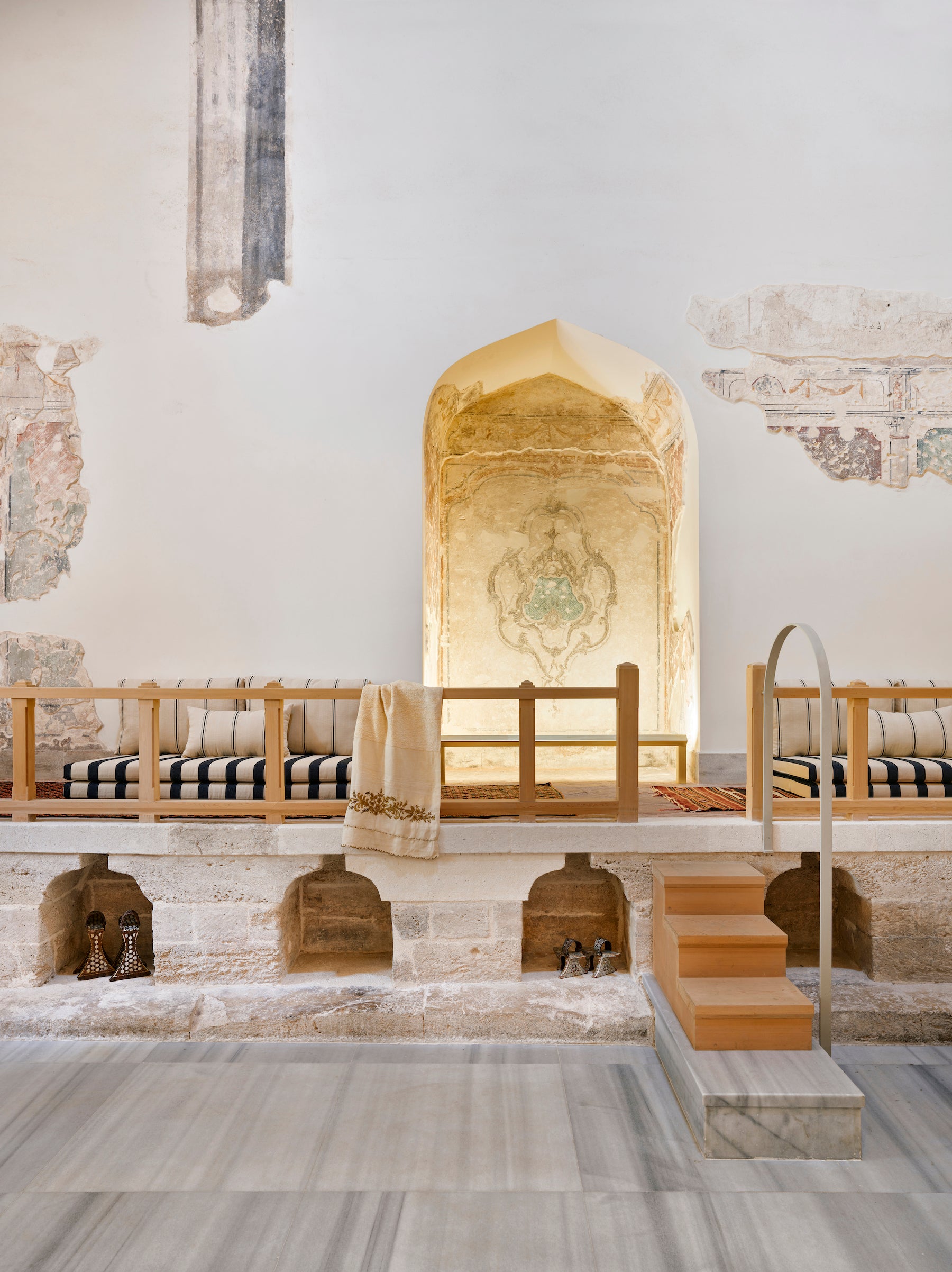To bathe is to fall into step with your biological rhythms.
—Leonard Koren, Undesigning the Bath
In a world constantly urging us to move faster, achieve more, and embrace the hustle, there’s a counter-movement gaining momentum, namely the art of slow living. It finds beauty in patience, serenity in stillness, and richness in taking one’s time. At its core, slow living is about embracing the present moment, acting with intention, and savoring life’s experiences. Hammam culture is a quintessential example, offering as it does a rich opportunity to practice the art of slowing down.
Hammam, a word that means “spreader of warmth” in Arabic, is a bathing tradition rooted in the heart of the Middle East. It traces its origins back more than two millennia, to a time when the role of water in human life was almost sacred.

Zeyrek Çinili Hamam, interior, photo by Murat Germen
The Ritual of the Hammam
The hammam ritual, as practiced since the days of the Ottoman Empire, unfolds like a carefully orchestrated symphony. Picture this: a sequence of rooms, each distinct in character and serving a distinct purpose, leading you on a journey of physical, mental, and ideally even spiritual relaxation. It starts with the vestiary—a welcoming cool room— which eases you into the serene ambiance of the hammam. Here, you prepare to let go of the outside world and embrace the moment.
As you move deeper into the hammam, you encounter the warm room, where your body begins to adjust to the rising temperature. Here, visitors ease into the experience, allowing their bodies to acclimate to the gentle embrace of heat. Time seems to stretch, elongating moments as the senses awaken to the subtle symphony of warmth. Slowing down is not just encouraged; it is celebrated.
The pinnacle of the hammam experience lies in the hot room, where the hidden furnace works its magic, enveloping you in soothing warmth. In this space, the traditional five-step bathing ritual unfolds: warming the body, massage, sloughing off dead skin, soaping, and, finally, relaxation. Each step is an invitation to surrender, be fully present, and relish the sensations washing over you.
The ritual concludes in the cold room, where the invigorating embrace of coolness enlivens the body. Here, time reasserts itself, but bathers emerge from the hammam with a sense of renewal, as if they’ve glimpsed a dimension beyond the ticking seconds of everyday life.

Image on the left: Zeyrek Çinili Hamam, Women’s Cold Room, photo by Ibrahim Ozbunar
 Image on the right: Zeyrek Çinili Hamam, Hot Room, photo by Murat Germen
Image on the right: Zeyrek Çinili Hamam, Hot Room, photo by Murat Germen
A Sanctuary of Social Connection
The bathhouse itself was once an institution, dedicated not just to providing essential sanitation, but designed for health and pleasure, as well as being a place of relaxation and rejuvenation, and social, cultural and political exchange.
—Jane Withers, Soak, Steam, Dream
But the hammam isn’t just about individual indulgence or cleansing or purifying the body. Instead, it’s a space for profound social connection, for traditional rituals that mark pivotal moments, and for celebrating significant life milestones. During the Ottoman period, it was a melting pot of diverse cultures and backgrounds, where people from all walks of life could come together on equal footing. Especially in the bazaar hammams, segments of society could temporarily leave behind the boundaries that in other realms divided them. Visitors engaged in a wide range of activities, from singing and reciting poetry to heartfelt conversations.
Women—from likewise varied backgrounds—found freedom and empowerment in the hammam, a space where they were physically separated from men and societal norms were thus relaxed, allowing them to engage in interactions, rituals, and activities that were restricted in their everyday lives. They could mingle on equal terms, participate in cultural traditions, and enjoy a sense of liberation and freedom, both psychologically and physically, from the constraints of their usual roles.

Zeyrek Çinili Hamam, interior, photo by Murat Germen
The Spiritual Journey of the Hammam
For many, the hammam was a site for a spiritual journey; the Turkish ritual of bathing purified even the soul. These cathedral-like structures, with their grand domes and ornate architecture, echoed the ancient Roman baths (although unlike the Roman thermae, hammams are not designed for soaking; instead, they invited you to wash away the worries of the world by pouring buckets of water over yourself).
The central hot stone slab, where bathers prepared for the ritual, was potentially a sacred stage for transformation. As people moved through the rooms of varying temperatures—cold, warm, hot, cold—the thermal circuit of the hammam encouraged the body to sweat, offering a gateway to surrender on multiple levels.
A Modern Twist on a Timeless Tradition
Today, the hammam experience is an opportunity to slow down, rejuvenate, and surrender to the expert hands of your attendants, known as tellak or natir. In a world where we’re constantly urged to move faster, the hammam embodies the beauty of deceleration. It offers a haven for those who seek refuge from the relentless pace of modern life, a place where the art of slow living can be practiced with intention and grace.
As we step into the hammam, we enter a timeless sanctuary where the mantra is clear: move slowly, notice deeply, and savor the richness of the moment. In this gentle embrace of the present, we rediscover the profound joy of living slowly—an embodiment of the “slow burn.”



